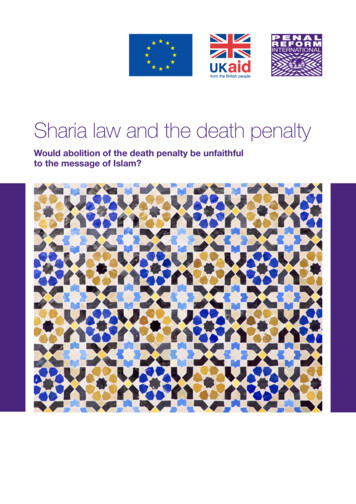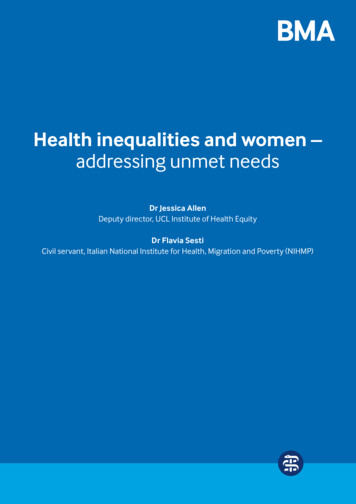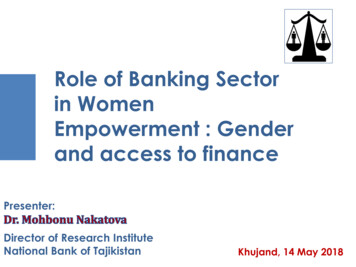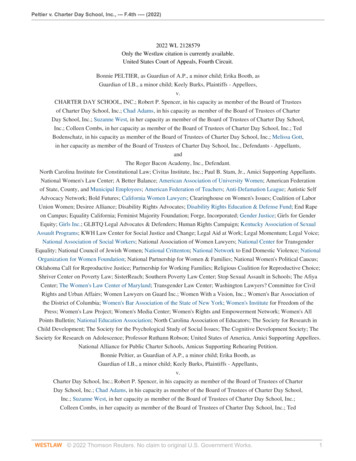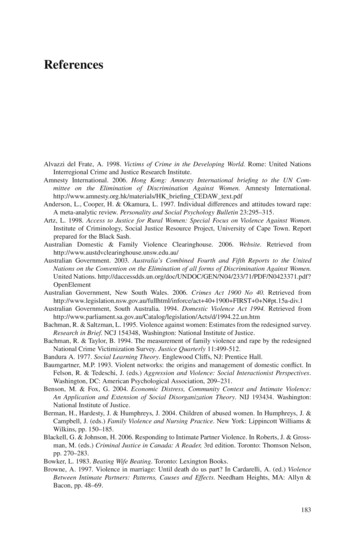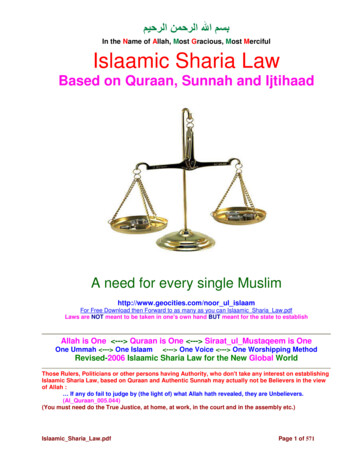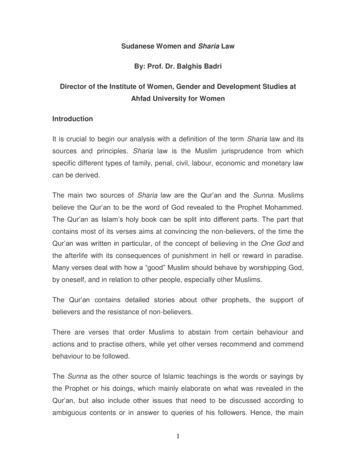
Transcription
Sudanese Women and Sharia LawBy: Prof. Dr. Balghis BadriDirector of the Institute of Women, Gender and Development Studies atAhfad University for WomenIntroductionIt is crucial to begin our analysis with a definition of the term Sharia law and itssources and principles. Sharia law is the Muslim jurisprudence from whichspecific different types of family, penal, civil, labour, economic and monetary lawcan be derived.The main two sources of Sharia law are the Qur’an and the Sunna. Muslimsbelieve the Qur’an to be the word of God revealed to the Prophet Mohammed.The Qur’an as Islam’s holy book can be split into different parts. The part thatcontains most of its verses aims at convincing the non-believers, of the time theQur’an was written in particular, of the concept of believing in the One God andthe afterlife with its consequences of punishment in hell or reward in paradise.Many verses deal with how a “good” Muslim should behave by worshipping God,by oneself, and in relation to other people, especially other Muslims.The Qur’an contains detailed stories about other prophets, the support ofbelievers and the resistance of non-believers.There are verses that order Muslims to abstain from certain behaviour andactions and to practise others, while yet other verses recommend and commendbehaviour to be followed.The Sunna as the other source of Islamic teachings is the words or sayings bythe Prophet or his doings, which mainly elaborate on what was revealed in theQur’an, but also include other issues that need to be discussed according toambiguous contents or in answer to queries of his followers. Hence, the main1
characteristic of Islam is that it is a religion that demands active faith ofobservance and practice. It is human-centred and emphasizes ideal humanrelations and behaviour. It is embedded in a call for communalism and socialjustice with degrees of individualism in property holding and in legal and faithresponsibilities. It is not characterized by emphasizing dichotomies of duality butrather by triple or quadruple classifications.As an international religion influenced by the many cultures that Islam spreadamongst from the start of its existence, the cultural diversity of its followers hasinfluenced issues of practice. Further, individual contexts and choices have led todiversity in observance varying from the original idea. All these factors have ledto a continuum in the religious practice, to a gap between the ideal and theactual. Further, the political, the socio-economic and the time context have led todiversity due to the use of Islam for political reasons, for identity formation, forcohesion or cleavage.The elusiveness of Islamic interpretation and the ability to use its elaborate textsin various directions has led to a diversity of ways in which Muslims can make itcongruent with the modern project of the West, enlightenment standards, humanrights principles or western feminism, to mention some, or to make itcontradictory and bring it into conflict with them. Consequently many versions ofIslamic interpretations, and schools have appeared and continue to do so. On theother hand, Sharia law developed almost two centuries after the revelationended. It was developed by great Muslim scholars when the Islamic state grewlarge and was in need of new laws, particularly since the early Islamic state canbe considered as a kind of a “federal system”.The first scholars developing such laws came from different regions of theIslamic state. The main four scholars who developed the four Madhhabs (Islamiclegal schools) were from what is currently Saudi Arabia, Iraq, Iran and CentralAsia.2
The scholars differed in the main principles by which Sharia law should bedeveloped. These principles are important for our analysis below.Sharia law is based on the following principles:1. Interpretation (ijtihād) of the Qur’an’s teachings refers to understandingwhat is meant and what is the purpose of what is written in the Qur’an anddeveloping the law according to it. The scholars given the right to conductijtihād are highly trained and specialized.2. Analogy (qiyās) is used where no clear instructions for a new issue arefound in the Qur’an or in the Sunna, but clear instructions were given for asimilar issue or context. Based on that similar laws can be drafted.3. Consensus (ijma al-umma) means that Muslim scholars agree that acertain issue is right or wrong and a law can be concluded accordingly.This is what generally is known as fatwa.4. The fourth principle is that of the common good (al-maslaha al- amma andal-masālih li dara al-mafāsid). This means that the state’s decisionmakers or religious scholars who are in decision-making positions couldstop or nullify an order in the Qur’an and the Sunna or make new differentinterpretations because the expected new rule is more in the interest ofbringing greater good and preventing an expected greater harm.It is important for scholars including Muslim feminists to understand the diversityin Sharia law in the different Muslim countries at different times. The varyingextent to which these principles are accepted and used can bring vitality andchange to Sharia law. There is another continuum, as the less a Muslim scholaror school refrains from accepting these principles and the more it abides only bythe words stated in the Qur’an with a rigid understanding, the more the resultingSharia law can be viewed as not contemporary. A further note of significance isthat religious scholars using ijtihād and other principles have mainly been males.Hence, the clergy is male-dominated and has had a deep impact on whether3
Sharia law can be “friendly to women” or restrictive and non-emancipatory. Thisissue will be discussed later.The research that has been conducted in Sudan by our institute with a team oflegal practitioners and activists, both academic and non-academic, in 2002 triedto assess how far Sudanese law developed since 1991 was based on Sharialaw. The assessment was based on the following criteria:1. Reference to international human rights standards2. Comparing and contrasting the individual laws themselves in regard totheir contradictions against the constitution. The latter itself is based onSharia principles.3. Reference to other contemporary Islamic interpretations or laws in otherMuslim countries which the research team considered to have a raryinterpretations or other respected scholars of the 10th to 14th century.Further, members of the team tried to make their own judgement using the abovecriteria to assess the following Sudanese legislation referring to women's rights:1. The Sudanese constitution of 19982. The Sudanese Family Law for Muslims of 19913. Sudanese Labour Law modification of 19974. Sudanese Penal "Criminal" Law of 19915. Sudanese Health and Reproductive Health Act of 1996 and 2002The paper will refer to the following issues in sequence:1. Definition of the age of consent in Sudanese law and its implications forgirls2. General violence against women in Sudanese legislation3. Citizenship and political rights gaps in law4
4. Rights in the labour law and inherent violence against women, as well asrecommendations for improvements5. Gaps and recommended amendments in the Penal Code to protectwomen and girls6. Women’s rights and problems in the Sudanese Family Law for MuslimsFurther, it is important to mention the sources of legislation for differentSudanese laws.The Sudanese Penal Code is based on Islamic Sharia applied to all Muslims andthose living in the northern parts of Sudan. The family law is based on thehusband’s religion, such as in the Muslim Personal Matters Act. Labour law andpolitical rights are based on international principles, while civil law is greatlybased on the heritage of British law. However, as the Islamization processprogressed, the inclusion of certain articles to amend the main Islamic rightsignored in the previous labour law was carried out.Moreover it is crucial to remember, that Sudan is party to the following maindeclarations and conventions:1. Universal Declaration of Human Rights (UDHR)2. International Covenant on Economic, Social and Cultural Rights (ICESCR)3. International Covenant of Civil and Political Rights (ICCPR)4. Convention on the Rights of Children (CRC)However, Sudan is not party to the following:1. Convention on the Elimination of all Forms of Discrimination AgainstWomen (CEDAW)2. Home Workers Convention (HWC)3. Equal Employment Opportunity (EEO)5
Definition of the age of consent in Sudanese law and problems it createsThe definition of the age of consent differs in the various laws. The majority inpolitical rights is reached at the age of 18 as set in the constitution, while in thePersonal Code the age of consent is defined by reaching puberty, which differsfor boys and girls, however for both a minimum of 15 years is recognized in thePersonal Code. Yet, the age of 10 is considered a possible age for marriage forgirls and the age of 16 is considered adult in the labour law of 1997. Thisdiscrepancy needs to be addressed by unifying the adult age to be 18 for alllaws. Defining puberty loosely puts girls at the risk of violence by being married inchildhood at an age as early as ten according to the family law. In the PenalCode of 1991 the hudud penalty (hudud are Qur’an based penalties) of adultery(zina) or other crimes can be applied to girls at age 12-13 if puberty isestablished. This can include whipping for up to 100 slashes or stoning. Hence, aunification of the age of consent definition would protect both girls and boys fromgender discrepancy or bias and from unduly violent punishment or practices.It is recommended that the age of legal adulthood is set at 18 in all law.General violence in Sudanese legislationViolence against women includes socio-cultural and other practices as well asthe law. Examples of violence against women by law are the Public Order Law of1992 and the State Public Order Acts of 1996 that restrict women’s work time inthe informal sector from 5 am to 5 pm and impose dress codes which are looselydefined in accordance to Islamic law, as well as the exit regulations of the visadepartment at the Ministry of Interior, were women need the permission to travelabroad from a male guardian before they are allowed to receive a visa.All laws of this kind were established to perpetuate and emphasize an ideologythat sees women as a source of possible shame and vice that society needs tobe protected from. These auxiliary laws and orders need to be abolished as theycontradict the Human Rights Declaration and the Sudanese constitution, which6
establishes the sanctity of innocence until proved guilty. Violence against womenneeds to be identified and recognised as a crime in all law, whether labour orfamily, and not left to the Penal Code only. Women's right to protection againstviolence must be clearly stated in different laws, and protection mechanismsneed to be established for all categories of women as will be elaborated below.Citizenship and political rightsThe Sudanese constitution and a substantial number of laws are based on theprinciple of equality without discrimination based on sex, religion or race.The constitution does not have a paragraph on women, however, familyprotection is indicated in its preamble. The constitution does not includeprovisions for the right to work, education, reproduction, development andprotection from poverty. Yet, other basic rights are guaranteed.Political RightsIn reference to the International Covenant on Civil and Political Rights, to whichSudan is party, equality in voting, standing for elections and in holding publicpositions is guaranteed by the constitution and the law. However, socio-culturaland ideological reasons still lead to discrimination. This could be overcome byvarious measures. Legal ones include an introduction of affirmative action by aquota system in election acts, by appointments in committees and by acompetitive quota system in executive and legislative bodies.Rights to nationalityThe Sudanese constitution of 1998 gives both parents the right to confernationality to all children equally. Yet, the nationality law has not been changedand the current law still only entitles fathers to such a right and does not complywith the constitution.Right to freedom of movement7
Though the constitution provides for the right to freedom of movement, otherlaws indicated in the Ministry of Interior Act restrict women’s travel abroad byrequiring permission from male guardians. Further, the Khartoum State PublicOrder Act prohibits women in the informal sector from working after 5 pm.Further, Sudanese women without a guardian can not stay in Sudanese hotelsalone, unless as a group, which then is in need of permission from the PublicOrder Police. This is also a non-constitutional act. Women's activists are callingfor the abandonment of the Public Order Act, especially articles 49 to 52, whichbasically target women.Rights in the labour lawIn general terms:The labour law guarantees women equality in payment, in promotion, and inbenefits. There are several protective measures for maternity. However, manyactivists agree that overprotective measures during maternity may restrict womenfrom work opportunities or promotions.Maternity benefits:The current law gives women the right to a paid leave of 8 weeks for maternity, afurther one year leave paid with a basic salary and another one year unpaidleave. Some activists believe a one-year leave is sufficient and the right needs tobe restricted to a birth rate of two children per family to encourage familyplanning.Violence against women in labour law and orders:The right to work is not included in the Sudanese constitution, while in thePersonal Matters Law the husband’s/guardian’s right to obedience, whichincludes forbidding women to work, hampers women’s rights to work and topromotion. Moreover, male bias and prejudice against females restrains women’s8
employment and promotion opportunities at top levels both in the governmentaland private sector.The labour law does not lay stress on violence against women. It seems that thishas been left for the criminal law although the need for handling this issue in thelabour law is vital. Violence against women in workplaces ranges from physicalassault to different forms of sexual harassment. Remedying this issue throughthe labour law can help sensitize and raise the whole community’s awareness towomen’s right to protection against violence.Various laws in the Labour Act of 1995 and 1997 are the result of the ideologicalmotivation to bring the law in line with the drafters’ interpretation orunderstanding of Sharia. To give some examples of this:1. The Public Service Regulation Act of 1995, section 43-C, refers to womenemployees’ decent dress in accordance with Sharia. This is a subjectiverule, which violates women’s right to choice of dress as part of individualfreedom, puts them under their employers’ judgement of what is decent,and discriminates between Muslims and non-Muslims if not applied tonon-Muslims.2. Another example is the idda right (the right of a Muslim widow to 4 monthsand 10 days full paid work leave if not pregnant, and until birth ifpregnant). This right is given only to Muslim employees, whichdiscriminates against non-Muslim female employees. Further, it does notgive men such a right! The law is based on a custom rather than areligious order.3. The Pension Act of 1992 defines family in a way that excludes childrenborn out of wedlock from rights to pension. This needs to be changed togive this right to all recognized children.4. The same act defines the retirement age as 55 years for women and 60years for men. The differentiation between men and women in the9
retirement age is not justified and we propose equality in the retirementage for both at age 60.5. The 1996 Public Order Act of Khartoum State prohibits women fromengaging in petty trade in public places before 5 am and after 5 pm. Thereis no such restriction applied to men. Also, women without licences arefrequently arrested and all their belongings confiscated. Moreover, they gothrough enormous hardships in order to obtain their licences. Thus, thesemeasures clearly discriminate against women and their market mobilitywithin their community. Measures to make obtaining licences easier areneeded. Further, the time restriction needs to be abolished.Main gaps in the law:1. No reference is made to establishing specific laws on women’s protectionfrom violence in the workplace.2. Further, laws for home workers are missing, as the Labour Act of 1997does not cover this category, nor has Sudan ratified the Home WorkConvention. Though the law does not explicitly discriminate any more,equality of opportunity is not mentioned in the Sudanese labour law.3. The current Labour Act does not cover the protection of women in theinformal and in the agricultural sector.4. Dismissal during maternity leave is not prohibited in law.Consequently, as Sudan is approaching a new peace agreement which entailslaw reform, it is crucial that in such a reform the following is taken care of:1. Ratifying the above-mentioned conventions and making law amendmentsaccordingly.2. Abolishing the above-mentioned articles that entail discrimination andviolence.10
3. Abolishing articles related to women’s dress code at work and timerestrictions for informal work as laid out in the Public Order Act ofKhartoum State and likewise similar provisions in other states.4. Operationalizing the maternity protection rights and including theprotection from dismissal during maternity leave in the law.5. Protecting women working in the informal and agricultural sector byformulating laws that draw from the labour law in a broader understandingthan by only considering the formal sector, since the majority of workersactually work within the informal sector.Gaps and amendments in the Penal CodeThe current Penal Code defines the age of adulthood as 16 for crimes that do notinvolve hudud, whereas for hudud puberty is taken as the age of adulthood andpunishment. Hence, adolescents of age 18 can face death penalties according tohudud and adolescents aged 12-17 years can receive the humiliating punishmentof whipping.The law discriminates against girls by defining the age of consent as puberty.Further, hudud punishments are violent in cases of adultery, whereas thedistinction between rape and adultery (zina) is not well demarcated for adults.This makes women afraid of being accused of zina and punished for it, which iswhy they often will forsake their right to report rape. Rape of and incest withchildren are well defined. However, the punishment is considered as ratherminor.In the Sudan Penal Code of 1991 there is no reference to juvenile courts andadolescents appear before the ordinary criminal courts, which is contradictory tointernational standards and the Convention on the Rights of Children (CRC).Zina (Adultery)11
Adultery is one of the crimes committed with the consent of both parties. Section145 of the Sudan Penal Code of 1991 defines adultery as follows:Adultery is said to be committed by:a. A man who has sexual intercourse with a woman with her consent,who is not his wifeb. A woman who consents to a man to have sexual intercourse withher without being her husbandAdultery is to be proved by the testimony of four male witnesses or by confessionof the offender. Retraction of the confession or the testimony of one of thewitnesses remits the penalty of adultery.Penalties vary according to the marital status of the offenders and their religions: Execution by stoning for married offenders Whipping of 100 lashes for unmarried offenders Imprisonment for a term not exceeding one year, a fine, or both forunmarried non-Muslim offenders from the southern states Three years’ imprisonment for married offenders from the southern statesliving in the North of the Sudan, even though they are Christian. South Sudanesepeople are treated as exceptions because Sharia law is not to be implemented inthe Christian region of the country which is defined only as the southern states.Female Genital Mutilation (FGM)No law clearly outlaws FGM in the current law. The previous law of 1973incriminated only infibulations, however, not as part of the public law. Also, the1991 Sudan Penal Code abolished the previous law that existed from 1947 to1982. Yet, that law was not based on making FGM a public crime, but rather apersonal issue.12
The debate over the importance of such a law has led to recommendations thatall types of FGM should be considered public crimes. A specific law should beamended in the Penal Code including a punishment for the circumciser, theparents and any others who encouraged and participated. The force of the lawalong with other measures is believed to deter many from the practice. Further,the presence of a law indicates the government’s commitment to abolishing FGMand erodes the debate over its legitimacy. Such a law could be based on theprinciple of the public good.AbortionThe Sudanese Penal Code indicates the punishment for those who cause awoman to miscarry as paying dia’ (blood money) and imprisonment if it isintentional. Legal abortion is stipulated under certain conditions as follows: Pregnancy is detrimental to the mother’s life Pregnancy is the result of rape, which has occurred not more than 90 daysbefore and the pregnant woman has decided to abort It is proved that the premature baby has died in the mother's wombWhoever performs an illegal abortion is to be punished. The punishment can beimprisonment for not more than 5 years, a fine, or both.Acts that lead to the abortion or the death of a premature baby (foetus) are alsopunishable (Section 136-137). The punishment can either be 2 years’imprisonment, a fine, or both. This does not affect the right to dia’, i.e.compensation in money for causing the death to be paid to the mother, if she isnot the cause of abortion herself.The three above-mentioned issues are specifically problematic to women andneed to be addressed. The issue of a law regarding FGM is discussed a lot byactivists and there is currently a strong lobby for passing a law. However,opposing groups are also active who campaign to stop a law prohibiting all types13
of FGM and rather seek to forbid only the most severe types including cutting.The struggle is ongoing.Another highly needed amendment through a more progressive interpretation ofthe Qur’an is to allow women to claim rape under oath rather than being accusedof zina themselves in case of absence of witnesses, and to no longer acceptpregnancy as sole evidence of adultery. This would be a modern way toovercome hudud penalties based on the principle of the common good. Further,the stoning penalty needs to be banished from the law.Moreover, women should be allowed to abort a foetus within the first 90 days of apregnancy and an article should be introduced in the law according to the Muslimscholars’ definition that the soul is created in the foetus only after this timeperiod. Hence, there is no killing or loss of a soul involved if an abortion is carriedout before the 90th day. Some scholars even mention a period of up to 120 days.This could be considered a modern ijtihād.Women’s Rights and problems they face in the Sudanese Family Law forMuslimsBefore 1991 Muslims in Sudan were governed by Sharia law but nocomprehensive law was formulated, rather the Sharia judges and the supremeSharia judge, the Mufti, were given the right to develop specific rules or actscalled manašir (manashir), messages from the Mufti Council, to judge on variousissues. They could always develop new rules or nullify older rules if they wereproved not to be in the interest of the common good. This arrangement wouldhave made the law flexible for introducing changes to some extent. However, asthe main Sharia supreme judicial council mainly consists of men who are usuallydetached from new discourses concerning new interpretations as well as thefeminist movement, their actual flexibility to introduce positive change has beendoubted.14
In 1991 the current government formed a committee of 10 persons, only two ofwhom were women, to develop the current comprehensive Muslim Family Law.The law deals with the following main issues:1. Marriage: validity, eligibility, legality, rights of spouses2. Divorce: causes, means, implications, rights of divorcees, distribution ofproperty and custody over children3. Inheritance: eligibility, division of heirlooms amongst heirs4. Parents’ and children’s rights, rights of children over parents and viceversaEvaluation of marriage rightsWomen’s rights in entering marriage:Women have the right to consent to marriage, but this is conditional on obtaininga male guardian’s approval, i.e. his view that the groom is competent and equalin status to his daughter. This is a loose definition of competence and equality. Itis made to control the girls’ right to choose a partner. Male guardians can claimthe nullification of a marriage if a girl decides to marry on her own against theguardian’s will. The court can support his claim. Another condition for marriagevalidity is to have reached the required age of puberty, or alternatively to obtainthe guardian’s and a judge’s consent prior to puberty, as early as age 10. This isa major weakness and activists have been campaigning for an age restriction onmarriage. Opponents claim that reality already shows the average age ofmarriage rising to 19 in rural areas and 22 in urban areas. However, the lack of alaw puts a number of girls at risk.Women have the conditional right to make stipulations at the time of the marriagecontract. However, in practice it is considered a shame for a girl's family ifstipulations are made. It is also considered humiliating for the husband to acceptor expect stipulations. Consequently this right is rarely used. The only solution to15
overcome the cultural inhibition is by changing the marriage contract to includestipulations by default. Stipulations can include to allow the wife to pursueeducation, or work, to divorce at will without being overruled in court, to forbid thehusband to marry over her, to decide on where the marital couple should live.The first two issues are considered easy and do usually not incur problems,however, husbands will be resistant to accept the last three.Women's rights in marriage:Women have the right to maintenance, but this is conditioned by her obedienceand living in the marital household. A woman has the right to visit her parentsupon the permission of the husband. On the other hand it is forbidden for thehusband to use the wealth of his wife. In the case of polygamy women have theright to just treatment.Activists consider the obedience and the control of a wife’s movement laid out inthe law humiliating and in opposition to the principle of an Islamic marriage basedon love and mercy as stated in the Qur’an.Women’s right to divorce and custody:A woman has the restricted right to file divorce in court, based on certainconditions, such as ill-treatment, lack of maintenance, lack of potency, orabandonment for one year. If she fails to prove any of the above mentioned, shecan leave the marital house for two years and then request to pay compensationto the husband in order to get a divorce. The court will declare her nāšiz (nashiz),which means “not obedient”. The court will form a committee of four relativesfrom both sides to seek reconciliation; if they fail, they make a recommendationfor the amount of compensation and the judge issues the final decision on thepayment and declares the couple divorced. In cases of husbands divorcing theirwives, a wife usually forsakes the payback of the latent bride wealth andcompensation with household property. In most cases relatives will press for himto divorce her, which is called a fidya (ransom) divorce, and is similar to khula.16
In case of divorce the wife has a conditional right to custody over children underthe age of 9 for girls and 7 for boys. After this she has to file a case in court forthe continuation of the custody. This right is more or less only granted to Muslimwomen, while non-Muslim mothers’ right to custody is highly limited by the law.In case the woman is remarrying or leaving the country of the husband'sresidence she loses the right to custody.Women’s rights as divorcees or widows:As a divorcee a woman has the right to maintenance for 3 months and 4 months,and as a widow for 10 days to be paid from the late husband’s fortune beforeinheritance distribution. Women also have the right to a distribution of householdproperty in case of divorce, but this is usually limited to the items that supposedlysuit a woman if she can not prove ownership.Husbands’ rights in marriage:It is a claimed right of the husband, that the wife has to take care of him, beobedient to him, and preserve him and his wealth. A wife has to look after herself(preserve her chastity) and his wealth in his absence.The husband has the right to take up to four wives without any restrictions andwithout needing the first wife’s permission.Husbands’ rights in divorce:A husband has the right to divorce his wife at will without the approval of a court.He can claim all household possessions that supposedly suit a man (such as acar, equipment and furniture). He has the right to custody over children beyondthe age of 7 for boys and 9 for girls. It is evident that the law is patriarchal andnot based on the equality principle. It is based on a selection of Qur’an verses,interpreted in a literal and isolated way without considering the totality of the17
marriage and sanctity of family principles in Islam. Following progressiveinterpretations the right to absolute divorce could be lessened by imposingrestrictions; polygamy could al
Ahfad University for Women Introduction It is crucial to begin our analysis with a definition of the term Sharia law and its sources and principles. Sharia law is the Muslim jurisprudence from which specific different types of family, penal, civil, labour, economic and monetary law can be derived. .


